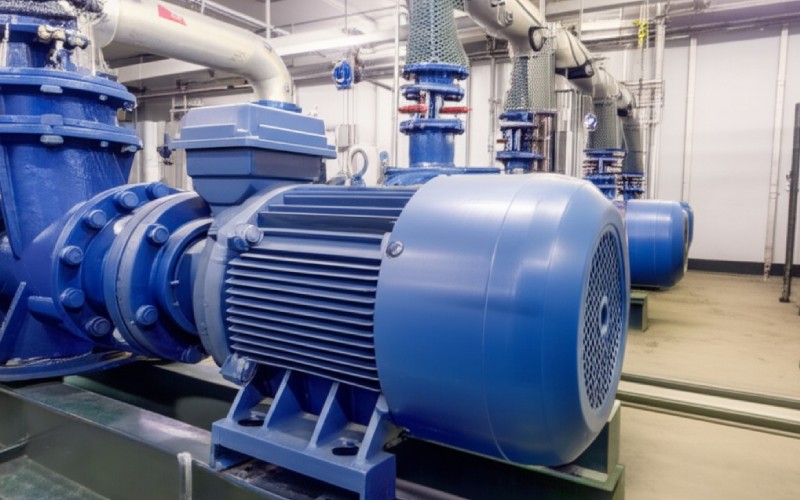Let Sino's Lamination Stacks Empower Your Project!
To speed up your project, you can label Lamination Stacks with details such as tolerance, material, surface finish, whether or not oxidized insulation is required, quantity, and more.

Specifically, the difference between an inverter duty motor and a standard motor. It might feel like a little detail, yet believe me, picking the wrong motor for your demands can cause large troubles. You might end up with a motor that doesn’t last, or one that does not get the job done right. This short article will aid you understand these two motor types. If you desire your motor to work well and conserve your cash, maintain reviewing!
A standard motor, often called a general-purpose motor, is the type of motor you see in several daily things. Think of fans, pumps, or straightforward equipment that just require to switch on and go for one stable speed. This type of motor is typically an induction motor, commonly with a squirrel cage rotor. These electric motors are made to work with clean AC power, like the kind that comes directly from your wall plug.
Standard motors normally expect a smooth, even flow of electrical power, usually a sine wave at 60Hz (that’s 60 times per second in North America). They do their task well under these conditions. The motor gets the power it needs and runs smoothly. A typical motor is constructed for a specific duty cycle, meaning how often it runs and rests. If you attempt to make this sort of motor do excessive, like adjusting speeds constantly, it may not be happy.
These motors don’t generally have special components to handle harsh power. Their insulation system is good for regular use, but not for the harsh conditions an inverter can impose. A standard motor is a workhorse for basic jobs. For several years, this was the major type of motor individuals utilized for almost every little thing. The motor is simple and finishes the job when the requirements are fundamental.
Now, let’s talk about an inverter duty motor. You might also hear it called an inverter-duty motor or an inverter-rated motor. The primary difference is that inverter duty motors are designed specifically to work with an inverter, also known as a Variable Frequency Drive (or VFD). This is a big deal because an inverter modifies the power going to the motor so it can run at different speeds. This is excellent for variable speed tasks.
An inverter duty motor has special features. It generally has a better insulation system. This special motor insulation can handle the electrical stresses and voltage spikes that an inverter can produce. Consider it like wearing a far better raincoat in a storm. This motor is likewise designed to run cooler, especially at reduced speeds. A standard motor might overheat if you attempt to run it too slowly with an inverter because its cooling fan, attached to the motor shaft, also slows down.
This type of motor offers a wider speed range than a standard motor. It can commonly provide continuous torque (that’s turning power) even when the motor’s speed changes a great deal. Some inverter duty motors can even give you full-rated torque at zero speed! This means the motor has solid holding power even when it’s not spinning. The motor is built to take the special type of power an inverter puts out.
An inverter alters the power in ways a standard motor isn’t built for. A standard motor expects smooth power, but an inverter creates a more complex electrical waveform to manage the motor’s speed.
This type of power can be harsh on a motor. The insulation inside a standard motor may break down faster because of voltage peaks from the inverter. This can bring about the motor failing sooner than you would expect. Also, a standard motor could overheat when operated at reduced speeds by an inverter. Its fan is usually attached to the motor shaft, so when the motor slows, the fan also slows, and it can’t cool down the motor sufficiently.
Utilizing a motor not designed for an inverter can likewise lead to other problems, like noisy bearing wear. The motor would be under stress it was never designed to handle. So, while you might be able to make a standard motor run with an inverter temporarily, it’s commonly not an excellent idea for long-term, trustworthy use. The motor should be ready for what the inverter sends its means.

An inverter, or VFD (which stands for Variable Frequency Drive), is a pretty creative box of electronics. Its major job is to regulate a motor’s speed. It does this by changing the frequency of the AC power going to the motor. For example, in North America, standard power is 60Hz. An inverter can transform this to 30Hz to make the motor run at half speed, or 90Hz to make it run much faster.
However, here’s a key point: the inverter does not produce a perfect, smooth sine wave of power like you get from the wall. Rather, most modern VFDs use something called Pulse Width Modulation, or PWM. This means the inverter sends out very rapid pulses of voltage to the motor. These pulses effectively present the motor with an average voltage and frequency that makes it run at the speed you desire. This PWM signal is what allows for precise speed control.
While PWM is excellent for managing speed, those rapid pulses can produce voltage spikes. These voltage spikes can be much higher than the normal voltage the motor anticipates. This is one of the primary reasons an inverter duty motor requires better insulation. The inverter helps the motor to do more, but the motor needs to be strong enough for the inverter’s unique power. The variable frequency output from the inverter is vital to this variable speed procedure.
So, when should you definitely use an inverter duty motor? The straightforward answer is: whenever you plan to use a VFD (Variable Frequency Drive) or inverter for more than just very occasional, light use. If your application’s requirements include changing the motor’s speed typically, or running the motor at reduced speeds for very long times, an inverter duty motor is normally the right motor.
Think about work like a conveyor belt that needs to speed up or slow down, or a pump that needs to adjust its flow. These are ideal examples where an inverter duty motor shines. Also, for applications requiring constant torque across a wide speed range, this type of motor is a must. A standard motor may lose its torque at lower speeds when run by an inverter. This motor delivers consistent torque.
If you require precise speed control or high dynamic performance (meaning the motor can change speed swiftly and properly), an inverter duty motor, often combined with an encoder for feedback, is the way to go. An encoder informs the inverter the specific rotor speed and position information. For constant torque applications, like mixers or extruders, an inverter duty motor is constructed to take care of the lots. When a motor is heavily stressed when operated with an inverter, this is it.
Somebody attempts to save a little money by utilizing a standard motor with an inverter when they truly shouldn’t. What can go wrong? Well, many points. First, the motor can overheat. The cooling fan on a standard motor slows down with the motor. At low speeds, the motor does not receive sufficient cooling and can become very hot. This warmth harms the insulation and bearings.
The voltage spikes from the inverter’s PWM output can attack the motor’s insulation system. A standard motor’s insulation isn’t typically designed to withstand the higher voltage spikes. With time, this can create the insulation to break down, resulting in a short circuit and a dead motor. This is one of the most common ways a standard motor fails when utilized with an inverter.
You could additionally hear unusual noises from the motor, or see motor shaft currents causing problems with the bearing system. The motor might not be able to provide adequate torque, especially at low speeds, so it can’t get the load up to speed or maintain it moving. In other words, making use of a standard motor where an inverter duty motor is needed can cause early motor failure, lost production time, and more expenses in the future. The motor simply isn’t built for that type of work.
Choosing between a standard motor or inverter duty motor boils down to understanding your needs. The first question is: will this motor be regulated by an inverter or VFD? If the response is yes, then an inverter duty motor is usually the safer and better choice for the motor and drive system.
Next off, think about the application’s requirements. What is the speed range required? Will the motor operate at low speeds for long periods? Does it need to create constant torque throughout its speed range? What is the motor’s duty cycle? Answering these helps determine which motor would be the best fit. Check out the nameplate data on your current motor if you’re replacing one, but additionally take into consideration if the application has changed.
If you need precise speed, variable speed operation, or if the motor is part of a system that requires high dynamic performance, you need to lean towards an inverter duty motor. If the motor simply requires to activate and go for a single, stable speed powered directly by AC power (like a straightforward fan), then a standard motor or general-purpose motor will likely do the job just great. Consulting with a motor expert can also help you find the motor suitable for your needs.
Can you ever before use an inverter with a standard motor? Occasionally, yes, yet with big “ifs” and “buts.” If a standard motor is only run by an inverter for a very limited speed range, say not too far below its normal 60Hz speed, and not for very long durations at those reduced rates, it might be alright. Additionally, if the motor is oversized for the load, it could manage the added stress a bit much better.
Some people add special filters between the inverter and the standard motor to suppress the voltage spikes. This can aid secure the motor insulation. There are also line reactors that can help. However, these add expense and complexity. You likewise need to be very careful about the motor overheating. A Totally Enclosed Fan-Cooled (TEFC) motor of standard design will have a hard time at reduced rates.
However here’s my honest advice: if you’re preparing to make use of an inverter regularly for variable speed control, it’s typically best to just get an inverter duty motor. Trying to make a standard motor work it wasn’t designed for usually brings about troubles later on. The peace of mind and reliability you receive from using the right motor for the job, like an inverter-duty motor, is often worth the additional initial cost. You need to think about whether to utilize a standard motor really carefully with an inverter.

When you consider a standard motor and an inverter duty motor from the outside, they might look quite comparable. Yet within, there are crucial distinctions, particularly in the motor insulation and motor cooling designs. These modifications make the inverter duty motor much tougher when collaborating with an inverter.
The most significant difference is the insulation system. Inverter duty motors make use of an enhanced insulation system. The wires in the motor windings have thicker, stronger insulation. This helps the motor hold up against the higher voltage spikes and voltage peaks that can originate from a VFD’s PWM output. A standard motor’s insulation is typically fine for smooth sine wave power, but not for the non-sinusoidal power from an inverter. This better insulation prevents early breakdown.
Inverter duty motors likewise commonly have better cooling. Some are designed to run cooler normally. Others may have special fans that provide good cooling even at low speeds, or they might be designed for a separate, constant-speed cooling fan (a blower). They also often tend to have more robust bearing systems, in some cases with insulated bearings to prevent electrical damage (from shaft currents). The rotor design in some inverter motors might additionally be optimized for variable speed efficiency. The overall motor construction is built for the demands of inverter operation.
Yes, choosing the right motor, particularly an inverter duty motor when utilizing an inverter, can make a large difference in energy consumption and how well your equipment performs. An inverter itself helps save energy by allowing the motor to run only as fast as needed. Yet if the motor isn’t compatible with the inverter, you may not obtain all those energy savings.
An inverter duty motor is designed to run efficiently across a wider speed range than a standard motor when powered by a VFD. This indicates it can offer high efficiency not just at full speed, but also at reduced speeds. A standard motor might lose efficiency and overheat when an inverter slows it down. A well-matched, efficient motor uses less energy.
For performance, an inverter duty motor offers you more reliable variable speed operation. It can deliver consistent torque, or even for constant torque applications, helping your machine perform its job better. If you require precise speed control for high quality or for applications where speed synchronization is critical, an inverter duty motor (perhaps with an encoder) provides better dynamic performance. The motor is capable of handling the demands, which implies smoother operation and an extra dependable process. Making use of the correct motor or inverter duty motor ensures the VFDs can do their work, and the motor delivers stable mechanical power for the application.